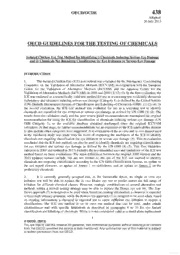
Test no. 438 [electronic resource] : isolated chicken eye test method for identifying PDF
Preview Test no. 438 [electronic resource] : isolated chicken eye test method for identifying
OECD/OCDE 438 Adopted: 26July2013 OECDGUIDELINESFORTHETESTINGOFCHEMICALS Isoalnatdedii)CChhiecmkiecnaElsyeNoTetsRteMqeutirhiondgfColrasIsdiefnitciaftyiionngfio)rCEhyeemiIcrarlitsatIinodnuocrinSgerSieoruisouEsyeEyDeaDmaamgaege INTRODUCTION 1. TheIsolatedChickenEye(ICE)testmethodwasevaluatedbytheInteragencyCoordinating CommitteeontheValidationofAlternativeMethods(ICCVAM),inconjunctionwiththeEuropean CentrefortheValidationofAlternativeMethods(ECVAM)andtheJapaneseCentreforthe ValidationofAlternativeMethods(JaCVAM),in2006and2010(1)(2)(3).Inthefirstevaluation,the ICEwasendorsedasascientificallyvalidtestmethodforuseasascreeningtesttoidentifychemicals (substancesandmixtures)inducingseriouseyedamage(Category1)asdefinedbytheUnitedNations (UN)GloballyHarmonizedSystemofClassificationandLabellingofChemicals(GHS)(1)(2)(4).In tchheemsieccaolnsdnoetvaclluaastsiiofni,edtfhoerIeyCeEitrersittatmieonthoordsewraiosuseveayleuadtaemdafgoeraussedeafsinaedsbcyreeUnNinGgHteSst(3t)o(i4d)e.ntTihfey resultsfromthevalidationstudyandthepeerreviewpanelrecommendationsmaintainedtheoriginal recommendationforusingtheICEforclassificationofchemicalsinducingseriouseyedamage(UN GtvoaHlaiSldsaotCiiaonntc.elgAuodtreythoatt1h)es,rtacagaset,etgnhooerifeuasrvtawhieelrarberleescuogdgmaemtseatbneaddsa.etAiroernems-aefivonareladunatueinxopcnahonafsnitgoheendionfsivtnihtcereoICtahEnedapiopnrlivigiciavnboaildliattIyaCsdeCotmVuasAieMnd inthevalidationstudywasmadewiththefocusofevaluatingtheusefulnessoftheICEtoidentify chemicalsnotrequiringclassificationforeyeirritationorseriouseyedamage(5).Thisre-evaluation cfoorncelyuedeidrrtihtaattiotnheaIndCEsetersitoumsetehyoeddcaamnagalesoasbedeufsiendedtobiydetnhteifyUcNheGmiHcSals(4)no(t5)r.eqTuhiirsinTgecsltasGsuiifidcealtiinoen (adoptedin2009andupdatedin2013)includestherecommendedusesandlimitationsoftheICEtest methodbasedontheseevaluations.Themaindifferencesbetweentheoriginal2009versionandthe c2h0e1m3icuapldsatneodtrveeqrusiiroinnginccllausdseif,icbauttionaraeccnoortdilnigmittoedthteo,UtNheGuHseSoCflatshseifiIcCaEtiotnestSymsetetmh,odantoupiddaetnteiftoy thetestreportelements,anupdateofAnnex1ondefinitions,andanupdatetoAnnex2onthe proficiencychemicals. 2. Itiscurrentlygenerallyacceptedthat,intheforeseeablefuture,nosingleinvitroeye irritationtestwillbeabletoreplacetheinvivoDraizeeyetesttopredictacrossthefullrangeof irritationfordifferentchemicalclasses.However,strategiccombinationsofseveralalternativetest Dmeotwhnodasppwriotahcihn(a7)(tiisedreeds)igtneestdintgobsetruatseegdywmhaeny,bbeasaebdleontoexriesptliancgeitnhfeorDmrataiiozne,eaycehetemsitca(6l).isTehxepeTcotpe-d tohavehighirritancypotential,whiletheBottom-Upapproach(7)isdesignedtobeusedwhen,based onexistinginformation,achemicalisexpectednottocausesufficienteyeirritationtorequirea classification.TheICEtestmethodisaninvitrotestmethodthatcanbeused,undercertain circumstancesandwithspecificlimitationsasdescribedinparagraphs8to10foreyehazard classificationandlabellingofchemicals.Whileitisnotconsideredvalidasastand-alonereplacement ©OECD,(2013) 1 YftoroouwmriattrhteeenfOrpEeeeCrmtDoi,suspsireoonvthifidrseodmmattthehereisaOolEufCroDcre.peisrsdounlayl,mennotni-ocnoemdm.eArnciyaclopmumreprocsieaslwuistehoouftthsiesekmiantegripariloriscsounbsjeenctt 438 OECD/OCDE fortheinvivorabbiteyetest,theICEtestmethodisrecommendedasaninitialstepwithinatesting ssterraitoeugsyesyuecdhaamsagtehe,Ti.oe.p,-cDheomwincaalpsptrooabcehclsausgsgiefsitededasbyUNScoGtHtSetCaal.te(g7o)rtyo1idweintthiofyutchfuermtihcearltsesitnidnugc(i4n)g. TeyheeiIrCriEtatteisotnmoertsheordioiussaelsyoerdeacmoamgmeenadseddeftionieddenbtyifythceheUmNicaGlHsStha(tNodoCnaottegroerqyu,irNeCc)las(s4i)f,icaantdionmafoyr thereforebeusedasaninitialstepwithinaBottom-Uptestingstrategyapproach(7).However,a chemicalthatisnotpredictedascausingseriouseyedamageorasnotclassifiedforeye irritation/seriouseyedamagewiththeICEtestmethodwouldrequireadditionaltesting(invitroand/or invivo)toestablishadefinitiveclassification.Furthermore,theappropriateregulatoryauthorities sthhaonultdhebeUNconGsHuSlt.edbeforeusingtheICEinabottomupapproachunderotherclassificationschemes 3. ThepurposeofthisTestGuidelineistodescribetheproceduresusedtoevaluatetheeye hazardpotentialofatestchemicalasmeasuredbyitsabilitytoinduceornottoxicityinanenucleated chickeneye.Toxiceffectstothecorneaaremeasuredby(i)aqualitativeassessmentofopacity,(ii)a qualitativeassessmentofdamagetoepitheliumbasedonapplicationoffluoresceintotheeye (fluoresceinretention),(iii)aquantitativemeasurementofincreasedthickness(swelling),and(iv)a qualitativeevaluationofmacroscopicmorphologicaldamagetothesurface.Thecornealopacity, swelling,anddamageassessmentsfollowingexposuretoatestchemicalareassessedindividuallyand thencombinedtoderiveanEyeIrritancyClassification. 4. DefinitionsareprovidedinAnnex1. INITIALCONSIDERATIONSANDLIMITATIONS 51.60(8),wThhiicshTweastsGdueivdeelloipneedifsoblalosweidngonthteheICpCroVtoAcMolisnutgegrensattieodnailnvtahleidOatEiConDstGuudiyda(1n)ce(3)Do(9c)u,mweintth contributionsfromtheEuropeanCentrefortheValidationofAlternativeMethods,theJapanese CenterfortheValidationofAlternativeMethods,andTNOQualityofLifeDepartmentofToxicology paunbdliAsphpeldiperdotoPchoalrs,maacsowleolglyas(tNheethceurrlraenndts)p.rotTohceolpursoetdocboylTiNsOba(s1e0d)(o1n1)i(n1f2o)r(m1a3t)io(n14)o.btainedfrom 6. AwiderangeofchemicalshasbeentestedinthevalidationunderlyingthisTestGuideline andtheempiricaldatabaseofthevalidationstudyamountedto152chemicalsincluding72substances and80mixtures(5).TheTestGuidelineisapplicabletosolids,liquids,emulsionsandgels.The liquidsmaybeaqueousornon-aqueous;solidsmaybesolubleorinsolubleinwater.Gasesand aerosolshavenotbeenassessedyetinavalidationstudy. 7cl.ihmeimtiactailonsTshtofeobrIeCthEcelatIsessCitEfmieteedtsthasomdeUtcNhaonGdbHeaSruesCbeaadtsetegodorioydnen1ttih(fe4y)h.cihWgehhmeifcanlasluesspeiodnsdifutoicrvientghriassteeprsuirofuposorseeay,lecotdhhoealmsiadgeaennt,difiti.ehe.ed, hcteoisngtthecxfhatelms(iecUanNlesgGatHthiSavteCcraoattmeegesofrooyurt1snoieldigedansttiiavfneidedwsouaursflnadcottbaenbtessiunb(gs1)eUq(uN3e)nGt(l9H)y.StHeCosatwteeedvgewoirrt,yhf1oa)tlhsaeerrenaendgoeatqtuciraviteteirlcaaytlevssailinincdeatthaeilsdl invitrotest(s),orasalastoptioninrabbits,dependingonregulatoryrequirements,usingasequential testingstrategyinaweight-of-evidenceapproach.Itshouldbenotedthatsolidsmayleadtovariable andextremeexposureconditionsintheinvivoDraizeeyeirritationtest,whichmayresultinirrelevant predictionsoftheirtrueirritationpotential(15).Investigatorscouldconsiderusingthistestmethodfor alltypesofchemicals,wherebyapositiveresultshouldbeacceptedasindicativeofseriouseye 2 ©OECD,(2013). OECD/OCDE 438 damage,i.e.,UNGHSCategory1classificationwithoutfurthertesting.However,positiveresults obtainedwithalcoholsshouldbeinterpretedcautiouslyduetoriskofover-prediction. I8.CEtestmWehtehonduhsaesdatnooivdeernatlilfyaccchuermaiccyalosfi8n6du%ci(n1g20s/e1r4i0o)u,saeyfealsdeampoasgietiv(eUrNatGeHofS6C%at(e7g/o1r1y3)1)a,ndthae faaclcsoerdnienggattiovetheraUteNofGH48S%cl(a1s3si/f2i7c)atwiohnesnysctoemmp(a4r)e(d5)t.oinvivorabbiteyetestmethoddataclassified 9f.oreyeirTrihteatiIoCnEortessetrmioeutsheoydecdanamaalgsoebuenduesredthteoiUdNentGifHySchcelmasisciafliscatthiaotndsoysntoetmr(e4q)u.iTreheclaaspspirfoipcraitaitoen regulatoryauthoritiesshouldbeconsultedbeforeusingtheICEinabottomupapproachunderother classificationschemes.Thistestmethodcanbeusedforalltypesofchemicals,wherebyanegative resultcouldbeacceptedfornotclassifyingachemicalforeyeirritationandseriouseyedamage. However,onthebasisofoneresultfromthevalidationdatabase,anti-foulingorganicsolvent- containingpaintsmaybeunder-predicted(5). 10. Whenusedtoidentifychemicalsthatdonotrequireclassificationforeyeirritationand seriouseyedamage,theICEtestmethodhasanoverallaccuracyof82%(125/152),afalsepositive rmaettehoofd3d3a%ta(c2l6a/s7s9i)f,ieadnadccaofradlisnegnteogatthieveUrNateGHofS1(%4)(1(5/)7.3)W,hwehnentecstomcphaemriecdaltsoiwnitvhiivnocrearbtbaiitnecyleastseesst t(riah.teee.,oIfaCn0tEi%-tfe(os0ut/l7i1nm)geftoorhrgotahdneiciUssN8ol3vG%eHnt(S1c2co3ln/at1sas4ii9nf)ii,cnagtthipeoanifnastlyssse)tpaeormsei(t4ei)xvc(el5)ur.adteed3f3r%om(2t6h/e78d)a,taabnasde,thethfealascecunregaactyivoef bsnU1ehu1Nom.cubGlleadHsrsSbiofeTfiNehcodUelaNaCsIsasCitGiEferHigretiSodetsratyatCismanctgehmeteitghmolooidrecdlyyayielsss1irnrc(ooiivht.teeea.rrmt,ciielncUcgaaosNltsmsoimGfeueeHnndydeSdeasersdCc(laUafUtNsoeNrsgiGtofGhriHeHyeSdiS2daCesnoaCtrtaiUetfCgeNiaogctaroeGtyrigyHoo2nS,r2yoB2fC)2AatAtedo)seurtgeooc2rrhBtye.tome2isFt,tcoharec2lhAstcehomitonsihrsacpitaud2lrseBsphrooatasubhnellad,edt furthertestingwithanothersuitablemethodmayberequired. 12. Allprocedureswithchickeneyesshouldfollowthetestfacility’sapplicableregulationsand proceduresforhandlingofhumanoranimal-derivedmaterials,whichinclude,butarenotlimitedto, tissuesandtissuefluids.Universallaboratoryprecautionsarerecommended(16). 13. WhilsttheICEtestmethoddoesnotconsiderconjunctivalandiridalinjuriesasevaluatedin tclhaessriafbibciattioocnuilnarviivroriwthanecnyctoenstsimdeetrihnogd,thietUadNdrGeHssSesClcaosrsniefaiclateifofne.ctAslswoh,icalhthaorueghthtehemarejvoerrsidbriilvietryooff craobrbnietaleyleessitoundsiecsa,nnthoattbaeneavsasleusastmeedntpeorfsteheinintihtiealIdCeEptthestofmectohrnoeda,liitnhjaursybmeaenypbreopuosseedd,tobaisdeendtiofny sometypesofirreversibleeffects(17).Inparticular,furtherscientificknowledgeisrequiredto understandhowirreversibleeffectsnotlinkedwithinitialhighlevelinjuryoccur.Finally,theICEtest methoddoesnotallowforanassessmentofthepotentialforsystemictoxicityassociatedwithocular exposure. 14. ThisTestGuidelinewillbeupdatedperiodicallyasnewinformationanddataareconsidered. Forexample,histopathologymaybepotentiallyusefulwhenamorecompletecharacterizationof cornealdamageisneeded.Toevaluatethispossibility,usersareencouragedtopreserveeyesand pfurretphaerreihmipsrtoopvaeththoeloagcycsupreaccyimoefnsthitshattesctanmebtehouds.edThtoedOevEeCloDphaadsatdaebvaesleopaenddadeGcuiisdiaonncceritDeoricautmheatntmaoyn 3 ©OECD,(2013). 438 OECD/OCDE theuseofinvitrooculartoxicitytestmethods,whichincludesdetailedproceduresonthecollectionof histopathologyspecimensandinformationonwheretosubmitspecimensand/orhistopathologydata (8). A15n.nex2Fsohroualndybleabuosreadt.oryAinlitaibaolrlayteosrtyabclainshiunsgethtihsesaessacyh,emtihcealpsroftiocideenmcoynscthreamtiecalthseiprrotveicdhenidcailn competenceinperformingtheICEtestmethodpriortosubmittingICEdataforregulatoryhazard classificationpurposes. PRINCIPLEOFTHETEST 16. TheICEtestmethodisanorganotypicmodelthatprovidesshort-termmaintenanceofthe chickeneyeinvitro.Inthistestmethod,damagebythetestchemicalisassessedbydeterminationof cornealswelling,opacity,andfluoresceinretention.Whilethelattertwoparametersinvolvea qualitativeassessment,analysisofcornealswellingprovidesforaquantitativeassessment.Each measurementiseitherconvertedintoaquantitativescoreusedtocalculateanoverallIrritationIndex, oeirthaesrsiagsnUedNaGqHuaSliCtaattievgeorcayte1goorriazsatUiNonGthHaStinsoun-sceldastsoifaisesdi.gnEiathnerinofvitthreoseocouultacrohmaezsarcdancltahsesnifbiceatuisoend, topredictthepotentialinvivoseriouseyedamageornorequirementforeyehazardclassificationofa testchemical(seeDecisionCriteria).However,noclassificationcanbegivenforchemicalsnot predictedascausingseriouseyedamageorasnotclassifiedwiththeICEtestmethod(see paragraph11). SourceandAgeofChickenEyes 17. Historically,eyescollectedfromchickensobtainedfromaslaughterhousewheretheyare killedforhumanconsumptionhavebeenusedforthisassay,eliminatingtheneedforlaboratory animals.Onlytheeyesofhealthyanimalsconsideredsuitableforentryintothehumanfoodchainare used. 18. Althoughacontrolledstudytoevaluatetheoptimumchickenagehasnotbeenconducted, theageandweightofthechickensusedhistoricallyinthistestmethodarethatofspringchickens traditionallyprocessedbyapoultryslaughterhouse{i.e.,approximately7weeksold,1.5-2.5kg). CollectionandTransportofEyestotheLaboratory s1h9.ock,andHeiandcissisohnooufldthbeenercekmofvoredbleiemdmiendgi.aAtellyocaalftseorursceedaotfiocnhiocfketnhsecclhoisceketnost,heusluaablolryatboyryeslhecoturlidc belocatedsothattheirheadscanbetransferredfromtheslaughterhousetothelaboratoryquickly enoughtominimizedeteriorationand/orbacterialcontamination.Thetimeintervalbetweencollection ofthechickenheadsandplacingtheeyesinthesuperfusionchamberfollowingenucleationshouldbe minimized(typicallywithintwohours)toassuremeetingassayacceptancecriteria.Alleyesusedin theassayshouldbefromthesamegroupofeyescollectedonaspecificday. 20. Becauseeyesaredissectedinthelaboratory,theintactheadsaretransportedfromthe slaughterhouseatambienttemperature(typicallybetween18°Cand25°C)inplasticboxeshumidified withtissuesmoistenedwithisotonicsaline. 4 ©OECD,(2013). OECD/OCDE 438 SelectionCriteriaandNumberofEyesUsedintheICE 2(i1..e.,>0.5E)yaefsterthtahteyhaarveeenhuicglheabtaesdelairneerefjleucotrede.sceinstaining(i.e.,>0.5)orcornealopacityscore 22. Eachtreatmentgroupandconcurrentpositivecontrolconsistsofatleastthreeeyes.The negativecontrolgrouporthesolventcontrol(ifusingasolventotherthansaline)consistsofatleast oneeye. 23. InthecaseofsolidmaterialsleadingtoaGHSNCoutcome,asecondrunofthreeeyesis recommendedtoconfirmordiscardthenegativeoutcome. PROCEDURE PreparationoftheEyes q24u.icklyasTsheesseeydelwiidtshaaredrcoarpefoufll2y%ex(cwi/sve)d,sotdakiiunmgfclauroerensocteitnodapapmlaigedettohethceorcnoeran.eaClorsnurefaalceinftoergraitfyeiws seconds,andthenrinsedwithisotonicsaline.Fluorescein-treatedeyesarethenexaminedwithaslit- lampmicroscopetoensurethatthecorneaisundamaged(i.e.,fluoresceinretentionandcorneal opacityscores<0.5). 25. Ifundamaged,theeyeisfurtherdissectedfromtheskull,takingcarenottodamagethe cornea.Theeyeballispulledfromtheorbitbyholdingthenictitatingmembranefirmlywithsurgical forceps,andtheeyemusclesarecutwithabent,blunt-tippedscissor.Itisimportanttoavoidcausing cornealdamageduetoexcessivepressure(i.e.,compressionartifacts). 26. Whentheeyeisremovedfromtheorbit,avisibleportionoftheopticnerveshouldbeleft attached.Onceremovedfromtheorbit,theeyeisplacedonanabsorbentpadandthenictitating membraneandotherconnectivetissuearecutaway. 27. Theenucleatedeyeismountedinastainlesssteelclampwiththecorneapositioned vertically.Theclampisthentransferredtoachamberofthesuperfusionapparatus(18).Theclamps shouldbepositionedinthesuperfusionapparatussuchthattheentirecorneaissuppliedwiththe isotonicsalinedrip(3-4dropsperminuteor0.1to0.15mL/min).Thechambersofthesuperfusion apparatusshouldbetemperaturecontrolledat32±1.5°C.Annex3providesadiagramofatypical superfusionapparatusandtheeyeclamps,whichcanbeobtainedcommerciallyorconstructed.The apparatuscanbemodifiedtomeettheneedsofanindividuallaboratory(e.g.,toaccommodatea differentnumberofeyes). 28. Afterbeingplacedinthesuperfusionapparatus,theeyesareagainexaminedwithaslit-lamp microscopetoensurethattheyhavenotbeendamagedduringthedissectionprocedure.Corneal thicknessshouldalsobemeasuredatthistimeatthecornealapexusingthedepthmeasuringdeviceon theslit-lampmicroscope.Eyeswith;(i),afluoresceinretentionscoreof>0.5;(ii)corneal opacity>0.5;or,(iii),anyadditionalsignsofdamageshouldbereplaced.Foreyesthatarenot rejectedbasedonanyofthesecriteria,individualeyeswithacornealthicknessdeviatingmorethan 10%fromthemeanvalueforalleyesaretoberejected.Usersshouldbeawarethatslit-lamp microscopescouldyielddifferentcornealthicknessmeasurementsiftheslit-widthsettingisdifferent. Theslit-widthshouldbesetat0.095mm. 5 ©OECD,(2013). 438 OECD/OCDE 29. Oncealleyeshavebeenexaminedandapproved,theeyesareincubatedforapproximately 45to60minutestoequilibratethemtothetestsystempriortodosing.Followingtheequilibration period,azeroreferencemeasurementisrecordedforcornealthicknessandopacitytoserveasa baseline(i.e.,time=0).Thefluoresceinscoredeterminedatdissectionisusedasthebaseline measurementforthatendpoint. ApplicationoftheTestChemical 30. Immediatelyfollowingthezeroreferencemeasurements,theeye(initsholder)isremoved fromthesuperfusionapparatus,placedinahorizontalposition,andthetestchemicalisappliedtothe cornea. 3(e1.g..,aspLairqtuoifdttehsetscthuedmyicdaelssiganr)e.tTyhpiecaplrleyfteersrteeddsuonldvielnuttefdo,rbduitlumtaeydtbeestdiclhuetmeidciafldseiesmpehdysnieocleosgsiacrayl saline.However,alternativesolventsmayalsobeusedundercontrolledconditions,butthe appropriatenessofsolventsotherthanphysiologicalsalineshouldbedemonstrated. 32. Liquidtestchemicalsareappliedtothecorneasuchthattheentiresurfaceofthecorneais evenlycoveredwiththetestchemical;thestandardvolumeis0.03mL. 33. Ifpossible,solidtestchemicalsshouldbegroundasfinelyaspossibleinamortarandpestle, orcomparablegrindingtool.Thepowderisappliedtothecorneasuchthatthesurfaceisuniformly coveredwiththetestchemical;thestandardamountis0.03g. 34. Thetestchemical(liquidorsolid)isappliedfor10secondsandthenrinsedfromtheeye withisotonicsaline(approximately20mL)atambienttemperature.Theeye(initsholder)is subsequentlyreturnedtothesuperfusionapparatusintheoriginaluprightposition.Incaseofneed, additionalrinsingmaybeusedafterthe10-secapplicationandatsubsequenttimepoints(e.g.,upon discoveryofresiduesoftestchemicalonthecornea).Ingeneraltheamountofsalineadditionallyused forrinsingisnotcritical,buttheobservationofadherenceofchemicaltothecorneaisimportant. ControlSubstances 35. Concurrentnegativeorsolvent/vehiclecontrolsandpositivecontrolsshouldbeincludedin eachexperiment. 36. Whentestingliquidsat100%orsolids,physiologicalsalineisusedastheconcurrent negativecontrolintheICEtestmethodtodetectnon-specificchangesinthetestsystem,andtoensure thattheassayconditionsdonotinappropriatelyresultinanirritantresponse. 37. Whentestingdilutedliquids,aconcurrentsolvent/vehiclecontrolgroupisincludedinthe testmethodtodetectnon-specificchangesinthetestsystem,andtoensurethattheassayconditions donotinappropriatelyresultinanirritantresponse.Asstatedinparagraph31,onlyasolvent/vehicle thathasbeendemonstratedtohavenoadverseeffectsonthetestsystemcanbeused. 38. Aknownocularirritantisincludedasaconcurrentpositivecontrolineachexperimentto verifythatanappropriateresponseisinduced.AstheICEassayisbeingusedinthisTestGuidelineto identifycorrosiveorsevereirritants,thepositivecontrolshouldbeareferencesubstancethatinducesa severeresponseinthistestmethod.However,toensurethatvariabilityinthepositivecontrolresponse acrosstimecanbeassessed,themagnitudeofthesevereresponseshouldnotbeexcessive.Sufficient 6 ©OECD,(2013). OECD/OCDE 438 invitrodataforthepositivecontrolshouldbegeneratedsuchthatastatisticallydefinedacceptable rangeforthepositivecontrolcanbecalculated.IfadequatehistoricalICEtestmethoddataarenot availableforaparticularpositivecontrol,studiesmayneedtobeconductedtoprovidethis information. 39. Examplesofpositivecontrolsforliquidtestchemicalsare10%aceticacidor5% benzalkoniumchloride,whileexamplesofpositivecontrolsforsolidtestchemicalsaresodium hydroxideorimidazole. 40. Benchmarksubstancesareusefulforevaluatingtheocularirritancypotentialofunknown chemicalsofaspecificchemicalorproductclass,orforevaluatingtherelativeirritancypotentialofan ocularirritantwithinaspecificrangeofirritantresponses. EndpointsMeasured 41. Treatedcorneasareevaluatedpriortotreatmentandat30,75,120,180,and240minutes(± 5minutes)afterthepost-treatmentrinse.Thesetimepointsprovideanadequatenumberof measurements over the four-hour treatment period, while leaving sufficient time between measurementsfortherequisiteobservationstobemadeforalleyes. 42. The endpoints evaluated are corneal opacity, swelling, fluorescein retention, and e4m5xo.crepphtoiloongiocfalflueoffreecstcsei(ne.rge.t,epnittitoinng(wohriclhooissedneintgeromfintehdeoenpliythperliiourm)t.oAtlrleatomfenttheanenddp3o0inmtisn,utweisthafttheer testchemicalexposure)aredeterminedateachoftheabovetimepoints. 43. Photographsareadvisabletodocumentcornealopacity,fluoresceinretention,morphological effectsand,ifconducted,histopathology. 4464.. Afterthefinalexaminationatfourhours,usersareencouragedtopreserveeyesinan appropriatefixative{e.g.,neutralbufferedformalin)forpossiblehistopathologicalexamination(see 4p7a.ragraph14andreference(8)fordetails). Cornealswellingisdeterminedfromcornealthicknessmeasurementsmadewithanoptical pachymeteronaslit-lampmicroscope.Itisexpressedasapercentageandiscalculatedfromcorneal thicknessmeasurementsaccordingtothefollowingformula: cornealthicknescsoartnetailmethtick-nescsoartnetailmeth=i0cknessattime=0 100 Themeanpercentageofcornealswellingforalltesteyesiscalculatedforallobservation timepoints.Basedonthehighestmeanscoreforcornealswelling,asobservedatanytimepoint,an overallcategoryscoreisthengivenforeachtestchemical(seeparagraph51). Cornealopacityisevaluatedbyusingtheareaofthecorneathatismostdenselyopacified forscoringasshowninTable1.Themeancornealopacityvalueforalltesteyesiscalculatedforall observationtimepoints.Basedonthehighestmeanscoreforcornealopacity,asobservedatanytime point,anoverallcategoryscoreisthengivenforeachtestchemical(seeparagraph51). 7 ©OECD,(2013). 438 OECD/OCDE Table1.Comealopacityscores. Score Observation 0 Noopacity 0.5 Veryfaintopacity 1 Scatteredordiffuseareas;detailsoftheirisareclearlyvisible 2 Easilydiscernibletranslucentarea;detailsoftheirisareslightly obscured 48. 3 Severecomealopacity;nospecificdetailsoftheirisarevisible;size ofthepupilisbarelydiscernible 4 Completecornealopacity;irisinvisible Fluoresceinretentionisevaluatedatthe30minuteobservationtimepointonlyasshownin Table2.Themeanfluoresceinretentionvalueofalltesteyesisthencalculatedforthe30-minute observationtimepoint,andusedfortheoverallcategoryscoregivenforeachtestchemical(see paragraph51). Table2.Fluoresceinretentionscores. Score Observation 0 Nofluoresceinretention 0.5 Veryminorsinglecellstaining 1 Singlecellstainingscatteredthroughoutthetreatedareaofthe cornea 2 Focalorconfluentdensesinglecellstaining 3 Confluentlargeareasofthecornearetainingfluorescein 49. Morphologicaleffectsinclude'‘pitting’'ofcomealepithelialcells,“loosening”ofepithelium, “roughening”ofthecomealsurfaceand“sticking”ofthetestchemicaltothecornea.Thesefindings canvaryinseverityandmayoccursimultaneously.Theclassificationofthesefindingsissubjective accordingtotheinterpretationoftheinvestigator. DATAANDREPORTING DataEvaluation 50. Resultsfromcornealopacity,swelling,andfluoresceinretentionshouldbeevaluated separatelytogenerateanICEclassforeachendpoint.TheICEclassesforeachendpointarethen combinedtogenerateanIrritancyClassificationforeachtestchemical. DecisionCriteria 51. Onceeachendpointhasbeenevaluated,ICEclassescanbeassignedbasedona predeterminedrange.Interpretationofcornealswelling(Table3),opacity(Table4),andfluorescein 8 ©OECD,(2013). OECD/OCDE 438 retention(Table5)usingfourICEclassesisdoneaccordingtothescalesshownbelow.Itisimportant tonotethatthecornealswellingscoresshowninTable3areonlyapplicableifthicknessismeasured dwsieifttftheirnaegntHatacao9grV-n2Se,tarleeqituthailcBlkiPnn9egs0s00.m0es9la5istu-mrlmeam.mpenUmtsisecrrisfostshcheoopsuellidtw-ibwtiehdtahdwesaperttethi-ntmgheaiatssudsirlfiiftne-grleandmtep.vimciecrnoos.co1peasndcosullidt-ywiiedltdh Table3,ICEclassificationcriteriaforcornealswelling. MeanCornealSwelling(%) ICEClass 0to5 I >5to12 II >12to18(>75minaftertreatment) II >12to18(<75minaftertreatment) III >18to26 m >26to32(>75minaftertreatment) HI >26to32(<75minaftertreatment) IV >32 IV Highestmeanscoreobservedatanytimepoint Table4,ICEclassificationcriteriaforopacity. MaximumMeanOpacityScore ICEClass 0.0-0.5 I 0.6-1.5 II 1.6-2.5 III 2.6-4.0 IV Maximummeanscoreobservedatanytimepoint(basedonopacityscoresas definedinTable1). Table5.ICEclassificationcriteriaformeanfluoresceinretention. Meaatn30FlmuionruetsecseipnoRsett-ternetaitomneSnctore ICEClass 0.0-0.5 I 0.6-1.5 II 1.6-2.5 III 2.6-3.0 IV BasedonscoresasdefinedinTable2. 9 ©OECD,(2013). 438 OECD/OCDE 52. TheinvitroclassificationforatestchemicalisassessedbyreadingtheGHSclassification thatcorrespondstothecombinationofcategoriesobtainedforcornealswelling,cornealopacity,and fluoresceinretentionasdescribedinTable6. Table6.Overallinvitroclassifications. UNGHS Combinationsofthe3Endpoints Classification NoCategory 3x1 2x1.1xTT Noprediction Othercombinations canbemade Category1 3xTV 2xIV,1xIII 2xIV.1xn* 2xIV.1xI* Cornealopacity>3at30min(inatleast2eyes) Cornealopacity=4atanytimepoint(inatleast2eyes) Severelooseningoftheepithelium(inatleast1eye) *Combinationslesslikelytooccur. StudyAcceptanceCriteria 5c3o.ncurrentAptoessittiisveccoonnstirdoelrsedaraecicdeepnttaibflieedifasthGeHcSoncNuornr-eCnltasnseigfaiteidveanodrGveHhSiclCea/tseoglovernyt1c,ornetsrpoelcstiavnedlyt.he TestReport 54. Thetestreportshouldincludethefollowinginformation,ifrelevanttotheconductofthe study: TestChemicalandControlSubstances - Chemicalname(s)suchasthestructuralnameusedbytheChemicalAbstractsService (CAS),followedbyothernames,ifknown; - TheCASRegistryNumber(RN),ifknown; - Purityandcompositionofthetestchemical/controlsubstanceorpreparation(in percentage(s)byweight),totheextentthisinformationisavailable; - Physicochemicalpropertiessuchasphysicalstate,volatility,pH,stability,chemicalclass watersolubilityrelevanttotheconductofthestudy; 10 ©OECD,(2013).
